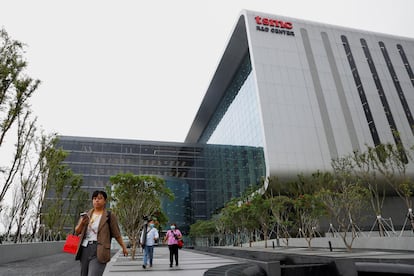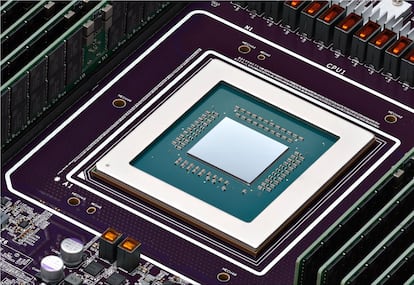The dead end of chips: Manufacturing semiconductors consumes as much energy as entire countries
The first half of 2024 marked a high point for Nvidia, the leading U.S. company in the chip industry. The firm tripled its global shipments of semiconductors, underscoring a prevailing truth of our time: the world is hungry for this tiny technology. However, the production of these semiconductors faces a significant challenge: the growing demand for electrical energy required for their manufacture. Experts warn that fulfilling the surging market demand for microprocessors may hinder the green transition. The sophisticated and intricate equipment used to print cutting-edge chips consumes vast amounts of electrical energy, which is essential for advancing technologies such as artificial intelligence and data centers.
Specifically, microprocessors — the tiny rectangular plates found in computers, washing machines, and cell phones — are manufactured using complex extreme ultraviolet lithography (EUV) machines. This process involves bathing silicon wafers, the foundational material for chips, in light waves that are invisible to the human eye.
According to Bloomberg, the latest models of these specialized devices consume around one megawatt of electricity, which is equivalent to the average energy consumption of a Spanish household over four months. A decade ago, the U.S. consulting firm McKinsey warned that a typical semiconductor manufacturing plant consumes as much energy annually as about 50,000 homes. The firm noted that these “mega factories” were using more electricity than automotive plants and refineries combined.

José Luis Costa, an expert in nanotechnology, acknowledges that this situation is currently not seen as a problem in most regions, “because it is a strategically critical sector where there will be no impediments to energy expenditure.” Beyond consumer electronics, the arms, space, and automobile industries have also made chips an indispensable part of their product development. According to the World Semiconductor Trade Statistics, global sales of microprocessors surged by 16.3% year-on-year at the beginning of this year, reaching $39.7 billion, and are projected to grow by another 13.1% in 2024.
The key player in the manufacturing of this technology is Taiwan, home to the leading chip manufacturer, Taiwan Semiconductor Manufacturing Company (TSMC). It is estimated that 60% to 70% of global chip production originates from this small island in East Asia. Bloomberg reports that due to the significant electricity consumption required to operate the lithography machines, TSMC is expected to soon consume more energy than the entire population of countries like Sri Lanka, which has 21 million residents. In 2020, the company accounted for about 6% of Taiwan’s total energy consumption, a figure projected to rise to 12.5% by 2025.
The problem is that Taiwan’s semiconductor industry is heavily reliant on fossil fuels, with more than 80% of its energy derived from burning coal and gas, according to data from the News Lines Institute think tank. To address this issue, in 2016, the island’s government aimed to obtain 20% of its electricity from renewable sources by 2025, by developing solar power and offshore wind capacity.
However, this target appears increasingly unattainable. The latest energy analysis, released in July, revealed that only 6% of energy was projected to come from renewable sources by the end of 2021, prompting officials to lower the target to 15%. As Liang Chi-Yuan, a professor of management at National Central University in Taoyuan, pointed out in a Bloomberg report, Taiwan will lack the necessary power capacity to support its semiconductor industry unless chipmakers begin constructing their own power supply plants.

Other countries with a long history of semiconductor manufacturing are facing a similar dilemma. In South Korea, tech giant Samsung operates six semiconductor manufacturing plants that accounted for 3% of the country’s energy bill in 2021. However, in its efforts to compete directly with TSMC in manufacturing chips for external customers, it plans to expand its number of EUV machines. This influx of new equipment poses a significant challenge to South Korea’s energy framework, which is also heavily reliant on coal and gas. Until 2018, approximately 80% of the country’s energy came from these fossil fuels, according to the Asian Development Bank.
“Chip manufacturing processes require extreme precision and rigorous control, often resulting in huge demands on electricity and water. In addition, many of the materials used in semiconductor manufacturing, such as silicon, require intensive, energy-intensive extraction and purification processes. For these reasons, this production model is not sustainable in the long term,” says Costa.
The industry contends that advancements in semiconductor technology are driving improvements in sustainability and energy efficiency in other areas. Taiwan’s Institute for International Industrial Technology Strategy argues that for every kilowatt of electricity produced by TSMC, the global energy savings could be up to four kilowatts.
Costa partially agrees with this perspective, noting that more sustainable methods of chip production are currently under investigation. These include using light to process information or exploring quantum states that promise to be highly efficient while significantly reducing energy consumption and environmental impact. For instance, Canon has announced plans to enter the lithography machine market — currently dominated by the Dutch firm ASML — through nano printing, which Costa claims could achieve similar results at a fraction of the cost and energy consumption.
Other players in the chip industry, such as Intel, are also striving to make their operations greener and more sustainable, albeit to a lesser extent. The American company has managed to surpass its Asian competitors in renewable energy usage, partly thanks to access to green energy at its facilities in Arizona, New Mexico, and Oregon. According to Bloomberg, Intel sourced 80% of its electricity from renewable resources in 2021, up from 71% the previous year. However, the media outlet also notes that overall electricity consumption is significantly increasing due to advanced manufacturing techniques.

In the race to dominate this complex market, which requires numerous layers of design and manufacturing, several countries have committed substantial funds to develop their own semiconductor manufacturing capacity, aiming to mitigate supply chain disruptions like those experienced during the pandemic. The United States has approved a $52 billion plan to establish its own factories, while the European Union has allocated €49 billion ($53 billion) to attract foreign investment. However, environmental considerations do not appear to be a major priority in either region. “The challenges are already too complex; in that context, energy and environmental arguments are, sadly, secondary,” says Costa.
The demand for lithographic machines continues to surge. Bloomberg Intelligence analyst Masharo Wakasugi predicts that ASML, the only company capable of designing and manufacturing these machines, will sell 30% more EUV machines this year, leading to increased energy consumption for manufacturing countries. “We must become aware as individuals of the emergency situation we are in and demand that something be done about it. If we do not act now, in 20 years we will feel the consequences,” he warns.
Sign up for our weekly newsletter to get more English-language news coverage from EL PAÍS USA Edition



